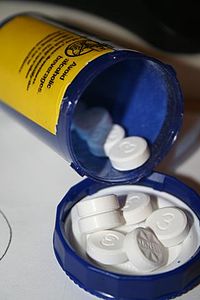- Co-codamol
-
Co-codamol Combination of Codeine Opioid analgesic Paracetamol Anilide analgesic Clinical data Pregnancy cat. C(US) Legal status Prescription Only (S4) (AU) POM (UK) Schedule III (US) Routes Oral Identifiers ATC code N02BE51 PubChem CID 11949633 ChemSpider 10123946 
 (what is this?) (verify)
(what is this?) (verify)Co-codamol (BAN) is a non-proprietary name used to denote a compound analgesic, a combination of codeine phosphate and paracetamol (acetaminophen). Co-codamol (or Tylenol w/ Codeine as it's known in the U.S. and Canada) tablets are used for the relief of mild to moderate pain when paracetamol (acetaminophen) or NSAIDS such as ibuprofen, aspirin or naproxen alone are not enough.
Contents
Formulations
Seven strengths are available:
- 8 mg of codeine phosphate per tablet
- 10 mg of codeine phosphate per tablet
- 12.8 mg of codeine phosphate per tablet
- 15 mg of codeine phosphate per tablet (in Canada, United States, Norway, Australia (multiple brands), United Kingdom)
- 20 mg of codeine phosphate per tablet (Prontalgine in France, Empacod, South Africa and Zimbabwe)
- 30 mg of codeine phosphate per tablet (available in capsules as Tylex, available in tablets/caplets as Solpadol, Kapake and Zapain).
- 60 mg of codeine phosphate per tablet (Tylenol-4 and generic equivalents)
Formulations contain from 300 mg to 1000 mg (1 gram) of paracetamol per tablet[1]. In the United Kingdom the 15/500 and 30/500 tablets are available only with a prescription, although the 8/500 and 12.8/500 strengths are available over-the-counter. In Australia the 30/500 tablets are available only with a prescription, and the 10/500 and 15/500 tablets are Schedule 3 (Pharmacist Only Medicine). Manufacturer directions state not to exceed more than the recommended dosage of two tablets every four hours, and no more than eight in a 24 hour period, also it is recommended not to take more than 2 at any one time. Other drugs containing paracetamol should be avoided.
In the United States and Canada, Tylenol produces tablets containing 8, 15, and 30 milligrams, named Tylenol No.1, 2, and 3, respectively. There is also a Tylenol 4 containing 60 mg of codeine. All tablets contain 300 mg of paracetamol. No Tylenol with codeine products in the U.S. contain caffeine. In Canada, preparations of Tylenol #1, #2 and #3 all contain 15 mg caffeine.
Co-codamol is marketed in the United States and Canada also under the generic name "Atasol Codeine". In the UK it is marketed as "Solpadeine Plus" and "Solpadeine Max", as well as "Solpadol". In Australia as "Panadeine", "Panadeine Extra" and "Panadeine Forte". Co-codamol is sold as "Paralgin Minor" (15/200), "Paralgin Forte" (30/400), "Paralgin Major" (60/800), "Pinex Forte" (30/500) and Pinex Major" (60/1000) in Norway.
Side effects
Side effects can include constipation, skin rashes, dizziness, sedation, shortness of breath, hypersensitivity reaction, fainting (syncope or near syncope), nausea and/or vomiting, confusion, loss of short-term memory, drowsiness, changes in blood, allergic reactions, euphoria, dysphoria, abdominal pain, pruritus (itching), easy bruising, bleeding gums, dry mouth and addiction.
Genetic differences between people give rise to differing rates of metabolism of codeine to morphine. In about 5% of people this may happen particularly fast, leading to higher levels of morphine being passed through breast milk in amounts potentially able to cause fatal respiratory depression of a breastfed baby.[2]
References
- ^ Tylenol with Codeine, from Drugs.com
- ^ CTV News, Codeine use while breastfeeding may be dangerous, Wed. Aug. 20 2008 9:42 PM ET
See also
- Co-proxamol
- Co-dydramol
- Co-codaprin
Categories:- Analgesics
- Combination drugs
- Opiates
Wikimedia Foundation. 2010.

